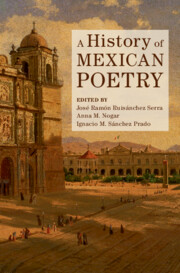Book contents
- A History of Mexican Poetry
- A History of Mexican Poetry
- Copyright page
- Contents
- Figures
- Contributors
- Introduction
- Chapter 1 The Practice of Epic and Lyric Writing in Colonial Mexico
- Chapter 2 La lírica del Fénix: Sor Juana’s Poetic Legacy
- Chapter 3 The Sound of the Word: Music and Social Transgression in Lyric Poetry from the Colonia Onward
- Chapter 4 We, the Romantics
- Chapter 5 Sentimental Sociabilities: The Young Romantics and Their Long-Lived Widows
- Chapter 6 Modernismo’s Strategic Occidentalism: Notes on Manuel Gutiérrez Nájera, Amado Nervo, and José Juan Tablada
- Chapter 7 The Crepusculars: Criollo Modernism and the Invention of the Literary Province
- Chapter 8 Poesía en voz alta: A Trajectory of Poetry and Performance in México
- Chapter 9 The Great Synthesis of the Critical Poets: The Rise of Octavio Paz
- Chapter 10 Octavio Paz and the Institutions of Poetry
- Chapter 11 The Form That Contains Multitudes: The Mexican Long Poem (1924–2020)
- Chapter 12 Radical Freedoms: Neobaroque, Postpoetry
- Chapter 13 The Age of Anthology
- Chapter 14 Twentieth-Century Mexican Poetry: The Popular and the Political
- Chapter 15 Poetry in Indigenous Languages: From the Sixteenth to the Twenty-First Centuries
- Chapter 16 Chicanx Poetry: The Living Lyric
- Chapter 17 Racimos: Dissonances in Mexican Poetry of Today
- Index
- References
Chapter 8 - Poesía en voz alta: A Trajectory of Poetry and Performance in México
Published online by Cambridge University Press: 21 March 2024
- A History of Mexican Poetry
- A History of Mexican Poetry
- Copyright page
- Contents
- Figures
- Contributors
- Introduction
- Chapter 1 The Practice of Epic and Lyric Writing in Colonial Mexico
- Chapter 2 La lírica del Fénix: Sor Juana’s Poetic Legacy
- Chapter 3 The Sound of the Word: Music and Social Transgression in Lyric Poetry from the Colonia Onward
- Chapter 4 We, the Romantics
- Chapter 5 Sentimental Sociabilities: The Young Romantics and Their Long-Lived Widows
- Chapter 6 Modernismo’s Strategic Occidentalism: Notes on Manuel Gutiérrez Nájera, Amado Nervo, and José Juan Tablada
- Chapter 7 The Crepusculars: Criollo Modernism and the Invention of the Literary Province
- Chapter 8 Poesía en voz alta: A Trajectory of Poetry and Performance in México
- Chapter 9 The Great Synthesis of the Critical Poets: The Rise of Octavio Paz
- Chapter 10 Octavio Paz and the Institutions of Poetry
- Chapter 11 The Form That Contains Multitudes: The Mexican Long Poem (1924–2020)
- Chapter 12 Radical Freedoms: Neobaroque, Postpoetry
- Chapter 13 The Age of Anthology
- Chapter 14 Twentieth-Century Mexican Poetry: The Popular and the Political
- Chapter 15 Poetry in Indigenous Languages: From the Sixteenth to the Twenty-First Centuries
- Chapter 16 Chicanx Poetry: The Living Lyric
- Chapter 17 Racimos: Dissonances in Mexican Poetry of Today
- Index
- References
Summary
This chapter is devoted to the forms of public activation of poetry. Such poetic performances comprise the spectacular (and heavily attended) mode of public performance that marked the success of Modernista poet Amado Nervo, and, later, the declamaciones by Berta Singerman. The decline of this type of dramatic performance was followed by more intimate poetic activations that can be traced through the recordings of collections such as Voz Viva de México. Even this sotto voce reading – in which the music of the verse plays a central role –has been challenged more recently by poets attuned to spoken word and poetry slam practices, and who have garnered considerable and well-deserved attention, among them Rojo Córdova, José Eugenio Sánchez, and Rocío Cerón.
Keywords
- Type
- Chapter
- Information
- A History of Mexican Poetry , pp. 143 - 159Publisher: Cambridge University PressPrint publication year: 2024



